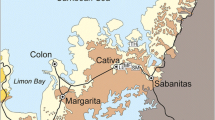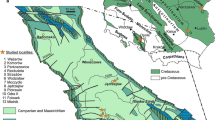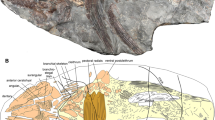Abstract
The platy limestone deposit of Vallecillo, located in north-eastern Mexico, offers a wide variety of invertebrate and vertebrate species dated to the latest Cenomanian-middle Turonian (Late Cretaceous). The deposit is known to contain well preserved fossils, e.g., fishes, in which the bones are recrystallized to calcite but soft tissue is also preserved. The fish assemblage is dominated by pelagic fast swimmers but also includes the common pycnodont Nursallia gutturosum, a discus-like and compressed fish that was likely well-suited for maneuverability. A review of 90 individuals of this taxon indicates the presence of different ontogenetic stages, from early young to old age. The size range distribution of individuals also suggests intermittent migration out of the Vallecillo area. The taphonomical decay analysis of N. gutturosum allows for a differentiation of five preservational stages. The presence of frequently complete and articulated specimens suggests a deep dwelling life style, without carcass flotation to the surface.










Similar content being viewed by others
References
Bieńkowska-Wasiluk, M. 2010. Taphonomy of Oligocene teleost fishes from the outer Carpathians of Poland. Acta Geologica Polonica 60(4): 479–533.
Blanco-Piñón, A. 2003. Peces fósiles de la formación Agua Nueva (Turoniano) en el Municipio de Vallecillo, Nuevo León, NE-México. Unpublished PhD thesis. Nuevo León: Universidad Autónoma de Nuevo León.
Blanco-Piñón, A., W. Stinnesbeck, J.G. López-Oliva, E. Frey, T. Adatte, and A.H. González-González. 2001. Vallecillo, Nuevo León: una nueva localidad fosilífera del Cretácico Tardío en el noreste de México. Revista Mexicana de Ciencias Geologicas 18(2): 186–199.
Blanco-Piñón, A., E. Frey, W. Stinnesbeck, and J.G. López-Oliva. 2002. Late Cretaceous (Turonian) fish assemblage from Vallecillo, Northeastern Mexico. Neues Jahrbuch für Geologie und Paläontologie, Abhandlungen 225(1): 39–54.
Buchy, M.-C., K.T. Smith, E. Frey, W. Stinnesbeck, A.H. González-González, C. Ifrim, J.G. López-Oliva, and H.G. Porras-Múzquiz. 2005. Annotated catalogue of marine squamates (Reptilia) from the Upper Cretaceous of northeastern Mexico. Netherlands Journal of Geosciences-Geologie en Mijnbouw 84(3): 195–205.
Elder, R.L., and G.R. Smith. 1988. Fish taphonomy and environmental inference in paleolimnology. Palaeogeography, Palaeoclimatology, Palaeoecology 62: 577–592.
Fletcher, T., J. Altringham, J. Peakall, P. Wignall, and R. Dorrell. 2014. Hydrodynamics of fossil fishes. Proceedings of the Royal Society (B: Biological Sciences) 281(1788): 20140703.
Frey, E., E.W.A. Molder, W. Stinnesbeck, H.E. Rivera-Sylva, J.M. Padilla Gutiérez, and A.H. González-González. 2017. A new polycotylid plesiosaur with extensive soft tissue preservation from the early Late Cretaceous of northeast Mexico. Boletín de la Sociedad Geológica Mexicana 69(1): 87–134.
Giersch, S. 2014. Die Knochenfische der Oberkreidezeit in Nordostmexiko: Beschreibung, Systematik, Vergesellschaftung, Paläoökologie und Paläobiogeographie. Unpublished PhD thesis. Heidelberg: Ruprecht-Karl-University Heidelberg.
Giersch, S., E. Frey, W. Stinnesbeck, and A.H. González-González. 2008. Fossil Fish Assemblages of northeastern Mexico: New evidence of mid Cretaceous Actinopterygian radiation. In 6 thMeeting of the European Association of Vertebrate Paleontology (EAVP), Spišská Nová Ves, Slovak Republic, Volume of Abstracts, ed. Z. Krempaská, 43–45. Spišská Nová Ves: Museum of Spiš.
Ifrim, C. 2006. The fossil Lagerstätte at Vallecillo, north-eastern Mexico: pelagic plattenkalks related to Cenomanian-Turonian boundary anoxia. Unpublished PhD thesis. Karlsruhe: University of Karlsruhe.
Ifrim, C., E. Frey, W. Stinnesbeck, M.-C. Buchy, A.H. González-González, and J.G. López-Oliva. 2005. The fish assemblage in early Turonian Carbonates at Vallecillo, N.L. México. Paleos Antiguo 1: 43–51.
Ifrim, C., S. Götz, and W. Stinnesbeck. 2011. Fluctuations of the oxygen minimum zone at the end of Oceanic Anoxic Event 2 reflected by benthic and planktic fossils. Geology 39(11): 1043–1046.
Ifrim, C., and W. Stinnesbeck. 2007. Early Turonian ammonites from Vallecillo, northeastern Mexico: taxonomy, biostratigraphy and palaeobiogeographical significance. Cretaceous Research 28(4): 642–664.
Ifrim, C., and W. Stinnesbeck. 2008. Cenomanian-Turonian high resolution biostratigraphy of north-eastern Mexico and its correlation with the GSSP and Europe. Cretaceous Research 29: 943–956.
Ifrim, C., W. Stinnesbeck, and E. Frey. 2007. Upper Cretaceous (Cenomanian-Turonian and Turonian-Coniacian) open marine plattenkalk deposits in NE Mexico. Neues Jahrbuch für Geologie und Paläontologie, Abhandlungen 245: 71–81.
Kriwet, J. 2001. Feeding mechanisms and ecology of pycnodont fishes (Neopterygii, Pycnodontiformes). Mitteilungen aus dem Museum für Naturkunde zu Berlin (Geowissenschaftliche Reihe) 4: 139–165.
Kriwet, J. 2004. A new pycnodont fish genus (Neopterygii: Pycnodontiformes) from the Cenomanian (Upper Cretaceous) of Mount Lebanon. Journal of Vertebrate Paleontology 24(3): 525–532.
Kriwet, J. 2005. A comprehensive study of the skull and dentition of pycnodont fishes. Zitteliana A45: 135–188.
Lucas, M.C., and E. Baras. 2001. Migration of freshwater fishes. Oxford: Blackwell Science Ltd.
Maguire J.-J., M. Sissenwine, G. Csirke, R. Grainger, and S. Garcia. 2006. The state of the world highly migratory, straddling and other high seas fishery resources and associated species. Rome: Food and Agriculture Organization of the United Nations. (= FAO Fisheries Technical Paper 495).
Nursall, R.J. 1996. Distribution and ecology of pycnodont fishes. In Mesozoic Fishes—systematics and Paleoecology, eds. G. Arratia and G. Viohl, 115–125. München: F. Pfeil.
Poyato-Ariza, F.J., and S. Wenz. 2002. A new insight into pycnodontiform fishes. Geodiversitas 24(1): 139–248.
Reisdorf, A.G., R. Bux, D. Wyler, M. Benecke, C. Klug, M.W. Maisch, P. Fornaro, and A. Wetzel. 2012. Float, explode or sink: postmortem fate of lung-breathing marine vertebrates. Palaeobiodiversity and Palaeoenvironments 92: 67–81.
Shimada, K., M.J. Everhart, R. Decker, and P.D. Decker. 2010. A new skeletal remain of the durophagous shark, Ptychodus mortoni, from the Upper Cretaceous of North America: an indication of gigantic body size. Cretaceous Research 31(2): 249–254.
Stinnesbeck, E.S. 2013. Vergleichende Studie zur Taphonomie rezenter Knochenfische (Amia calva und Lepisosteus oculatus) mit Fossilfunden aus dem Eozän der Grube Messel. Unpublished Bachelors thesis. Bonn: Rheinische Friedrich-Wilhelms University.
Stinnesbeck, W., E. Frey, and P. Zell. 2016. Evidence for semi-sessile early juvenile life history in Cretaceous ammonites. Palaeogeography, Palaeoclimatology, Palaeoecology 457: 186–194.
Viohl, G. 1994. Fish taphonomy of the Solnhofen Plattenkalk—an approach to the reconstruction of the palaeoenvironment. Geobios 16: 81–90.
Acknowledgements
Eva Susanne Stinnesbeck thanks Wolfgang Stinnesbeck who introduced her to the Vallecillo locality in Mexico. We are grateful to Ing. Mauricio Fernández Garza who provided generous access to his private collection of fossils. Logistic assistance and access to the Museo del Desierto (MUDE) collection of Vallecillo fossils were provided by Arturo González and José Manuel Padilla Gutierrez. We gratefully acknowledge the constructive reviews of this manuscript by John Joseph Cawley and Lionel Cavin.
Author information
Authors and Affiliations
Corresponding author
Additional information
Handling Editor: Jürgen Kriwet.
Rights and permissions
About this article
Cite this article
Stinnesbeck, E.S., Rust, J. & Herder, F. Paleobiology and taphonomy of the pycnodont fish Nursallia gutturosum, based on material from the Latest-Cenomanian-middle Turonian Vallecillo platy limestone, Mexico. PalZ 93, 659–668 (2019). https://doi.org/10.1007/s12542-019-00461-2
Received:
Accepted:
Published:
Issue Date:
DOI: https://doi.org/10.1007/s12542-019-00461-2




